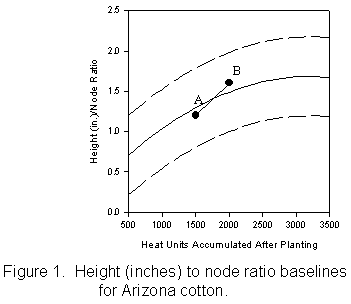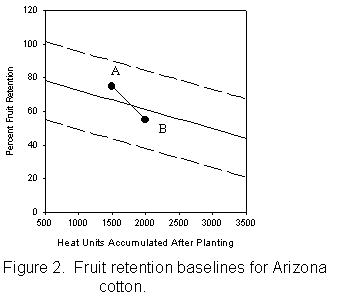In recent weeks the Arizona cotton crop has experienced considerable improvement. Under well-watered conditions and with the hot and dry weather that we had through most of June, most fields made substantial gains in terms of general vigor and fruit retention (FR). In some cases, maintaining good FR rates has been a problem, apparently due to dry winds and/or lygus damage. Many fields in the Yuma area are in peak bloom (or beyond) and most of the rest of the state is in early bloom. Relative to normal, most areas of the state are still behind. The Safford area is a notable exception, with most fields approaching peak bloom, showing good vigor, and fruiting vigorously.
When we entered the first of July, most of the cotton growing areas of Arizona experienced the effects of the first wave of monsoon season moisture. We have come to expect cotton fields to respond in a negative manner to the monsoon season. With the increases in humidity, as best noted by dewpoint temperatures > 55° F and increasing night temperatures, fruit abortion rates (particularly small, one to three day old bolls) will commonly increase, which they have. Along with declining FR under these monsoon conditions, plants have also experienced increased vegetative growth in many fields. Monitoring fields carefully and regularly with regard to both vigor (height:node ratio, HNR) and FR will be very important. In this sense, watching for trends in crop development will be critical in terms of adjusting management to maintain some reasonable control of the crop and maximize the yield potential.
When watching for trends in crop development, one of the most important and potentially dangerous trends to look for is a drop in FR and a corresponding increase in crop vigor (HNR). This type of transition is illustrated in Figures 1 and 2 for an example field and two dates of sampling (A and B). If this general type of pattern is detected in a field, consideration should be given to the following management options:
- Identify the cause of the decline in FR
- Implement appropriate insect control if necessary
- Reduce or withhold applications of fertilizer N, depending upon;
- amounts of N already applied
- N fertility status of the crop (petiole NO3 - -N concentrations)
- Initiate mepiquat chloride (PIXtm) applications
- Maintain good plant-water relations (avoiding crop stress)
- Irrigate at approximately 50% depletion of plant-available soil-water
- Do not over-water the crop or further encourage rank growth
Other important trends in crop development may also be detected. For example, increasing HNRs may be taking place without a drop in FR. Under this type of situation, all of the aforementioned management factors would still need to be considered, but mepiquat chloride applications may not result in improved FR, and benefit yield potentials directly. If HNRs are below the middle baseline (Fig. 1), vigor is not a problem, at least yet, and mepiquat chloride applications should not be initiated. Continue to monitor the crop for signs of increasing or excessive vigor (HNR) and declining FR. Tracking crop progression along the fruiting cycle and identifying important stages of growth will also be important aspects of crop monitoring and management (Table 1).
With the many delays in crop development that we have experienced this season, and the reductions in yield expectations relative to normal, there is a natural concern about the additional (or potential) impacts the monsoon season may have on this year’s crop. The most susceptible stage of development for a cotton crop in terms of FR loss due to monsoon-type conditions seems to be when the crop is carrying a good fruit load and experiencing a strong carbohydrate demand. Some fields in the Yuma area are in this position right now and are somewhat more vulnerable to current weather conditions. For the many fields that do not have much of a fruit load at this time, it may be possible for the plants to acclimate to the current conditions to some extent and maintain a reasonable level of fruiting and FR. Results from date of planting studies conducted in recent years indicate that some degree of adaptation may be possible.
In all cases it will be important for us to monitor fields regularly, maintain flexibility in management, and try to detect important transitions in crop condition and development. Despite the many problems and challenges that we have encountered thus far in the 1998 season, I still believe this crop may have some potential. The cotton plant has an amazing ability to respond to a wide range of circumstances and conditions and our management can impact conditions to some extent. Crop management also needs to be able to respond to the varied conditions that we encounter.
Table 1. Important growth stages for cotton development.
| Stage |
|||||||
| PHS |
MHS |
FB |
EB |
PB |
Cut-out |
|
|
|---|---|---|---|---|---|---|---|
| HUAP | 700 |
900 |
1200 |
1500 |
2000 |
2500 |
3000 |
| Nodes | 9 |
11 |
13 |
16 |
20 |
24 |
28 |
| NAWF | - |
- |
9-11 |
8-9 |
6-8 |
<=5 |
<2 |
Issued in furtherance of Cooperative Extension work, acts of May 8 and June 30, 1914, in cooperation with the U.S. Department of Agriculture, James A. Christenson, Director Cooperative Extension, College of Agriculture and Life Sciences, The University of Arizona.
The University of Arizona is an equal opportunity, affirmative action institution. The University does not discriminate on the basis of race, color, religion, sex, national origin, age, disability, veteran status, or sexual orientation in its programs and activities.
Any products, services, or organizations that are
mentioned, shown, or indirectly implied in this web document do not imply
endorsement by The University of Arizona.
Information provided by Jeffrey C. Silvertooth, silver@ag.arizona.edu
Extension Agronomist - Cotton, College of Agriculture, The University of Arizona.
Material written 10 July 1998.
Home | Cotton | Advisories
document located at: http://cals.arizona.edu/crops/cotton/comments/july1998cc.html
Copyright © 2001 University of Arizona,
College of Agriculture and Life Sciences
Webmaster: Al Fournier (acis@ag.arizona.edu)

